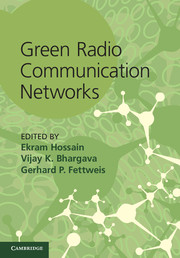Book contents
- Frontmatter
- Contents
- List of contributors
- Preface
- Part I Communication architectures and models for green radio networks
- Part II Physical communications techniques for green radio networks
- 5 Green modulation and coding schemes in energy-constrained wireless networks
- 6 Cooperative techniques for energy-efficient wireless communications
- 7 Effect of cooperation and network coding on energy efficiency of wireless transmissions
- Part III Base station power-management techniques for green radio networks
- Part IV Wireless access techniques for green radio networks
- Part V Green radio test-bed, experimental results, and standardization activities
- Index
- References
7 - Effect of cooperation and network coding on energy efficiency of wireless transmissions
from Part II - Physical communications techniques for green radio networks
Published online by Cambridge University Press: 05 August 2012
- Frontmatter
- Contents
- List of contributors
- Preface
- Part I Communication architectures and models for green radio networks
- Part II Physical communications techniques for green radio networks
- 5 Green modulation and coding schemes in energy-constrained wireless networks
- 6 Cooperative techniques for energy-efficient wireless communications
- 7 Effect of cooperation and network coding on energy efficiency of wireless transmissions
- Part III Base station power-management techniques for green radio networks
- Part IV Wireless access techniques for green radio networks
- Part V Green radio test-bed, experimental results, and standardization activities
- Index
- References
Summary
Introduction
There is a growing interest in studying and improving the energy efficiency of wireless transmissions to reduce CO2 emissions and to combat climate change. One promising technique to reduce the energy consumption of wireless transmissions is the use of cooperation between the nodes of the network, as cooperation has been proven to achieve performance improvements in wireless networks [1]–[3]. Cooperation can be achieved by adding relays that have better link qualities with the destinations than the source node, and hence can assist the source in transmitting the information to the target destinations. Another form of cooperation is user cooperation. User cooperation works whenever a source node is multicasting packets to multiple destinations: the destinations that first receive the data successfully from the source can assist the source in transmitting the data to the remaining destinations. This form of cooperation is motivated by the fact that some destinations may have better channel quality than the source node due to the nature of wireless channels. Hence, it is anticipated that this method will decrease the total energy consumed by the network to deliver the required data.
Relay cooperation is expensive since new resources (i.e. the relays) are added to the network. In user cooperation, on the other hand, no extra resources are added, and hence it is less expensive than relay cooperation. However, obtaining better performance is not always guaranteed in user cooperation since the users that act as relays may not always have better link quality with the remaining users than the source.
Information
- Type
- Chapter
- Information
- Green Radio Communication Networks , pp. 150 - 164Publisher: Cambridge University PressPrint publication year: 2012
